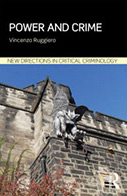Power and Crime

Author: Vincenzo Ruggiero
Publisher: London; New York: Routledge, 2015. 182p.
Reviewer: Paul R. Schupp | January 2016
The book is intended to provide a broad philosophical examination of two interrelated concepts of interest to criminologists: power and crime. In particular, Ruggiero is interested in how these concepts come together in the crimes of the powerful, or what he calls “power crime.” Power crimes, he says, are crimes committed by powerful entities such as corporations and states. Power crime reflects the asymmetrical abundance of degrees of freedom and resources with which to both commit crimes and to convince others not to define them as such.
Although Ruggiero does not explicitly state as much, his book is clearly premised on the belief that criminologists should care about power crime and study it more than we do. He claims that crimes of the powerful “do not lend themselves to the conventional understandings” of criminology, which he sees as a “now too well consolidated” discipline (p. 2). Consequently, the book is meant to help criminologists “migrate to other areas of expertise” (p. 2), such as classical social theory and even Greek philosophy.
In Chapter 2, A Criminological Classification, Ruggiero writes about power crime as an expression of the greater “degrees of freedom” that powerful actors have relative to non-elite offenders. Power, defined as material and symbolic resources, is asymmetrically distributed. In turn, powerful actors are both able to commit more, and more serious deviance — and either conceal or justify their deviance — thus shielding themselves from accountability, much more effectively than do non-elite deviants.
Crimes of the powerful are linked to how social power itself is formed and defined, distributed and altered. That is, power crime may actually accrue and accumulate social power, often being foundational to it. Complex organizational environments, in which goals and the modalities for achieving them become vague and negotiable, emphasize competition at all costs, and achieving high social status, may then encourage power and crime by engendering what Ruggiero calls a “fear of falling.”
Here he refers to a legal-illegal continuum, the now-familiar contests over which behavior by powerful actors should and should not be labelled and treated as real crime. As Ruggiero’s references show, critical criminologists going back to Edwin Sutherland himself have long argued that many of the behaviors on this legal-illegal continuum should rightfully be regarded as criminal deviance, when they are perpetrated by powerful actors. Ruggiero then provisionally classifies various crimes of the powerful: operative crimes of the powerful, gangster crimes of the powerful, crimes of the powerful by proxy, criminal power partnerships, philanthropic crimes of the powerful, and foundational crimes of the powerful.
In Chapter 3, Ruggiero argues that classical social theory has influenced criminology. He therefore samples some of the work of sociologists whose work focused on power and deviance, specifically Durkheim and Weber, Simmel and Merton, as well as C. Wright Mills and Foucault. It would be an ambitious task to seriously examine these prolific scholars’ influential works and meaningfully integrate their thoughts on power and crime. So it is surprising that the cursory sampling contained in this brief chapter fails to lead to any meaningful conclusions. The conclusion itself does not really match the chapter so much as it introduces thoughts only loosely related to the material. Indeed, the reader might ask if it is even possible to do so from just a sampling of social theorists such as these, whose methods and concepts were so seemingly disparate, and possibly even irreconcilable?
In Chapter 4, Ruggiero addresses some philosophical debates regarding how fundamentally the law, in a trans-historical sense perhaps, might relate to power crimes and the state. He discusses Greek philosophers Plato and Thrasymachus as two archetypal, opposing views of law and power. He takes Plato as the primordial philosopher of the justice and consensus view of the law in Western tradition, and Thrasymachus as his foil (“law as fraud”) positing a fundamentally conflict view of law and power. There has been a fundamental, long-running debate over the nature of law in highly asymmetrical societies that continues today, and naturally affects how we view and respond to power crime.
Ruggiero also addresses the matter of instability and the rules of exception, mainly considering work of early- and mid-20th Century German legal scholars Carl Schmitt and Franz Neumann on the relative importance of the law’s rationality and exception-making by sovereign state executives; ideas certainly relevant to state crimes and favored powerful entities. Problems may arise when there is a breakdown of the shared meaning of legal values and whether or not they are worth obedience. Powerful offenders are able to justify their “crimes,” perhaps with state support.
For thinkers like Schmitt, the rationality of law is not necessarily its most important consideration. The sovereign may declare exceptions, which might mean allowing power crimes that would otherwise be legally prohibited because the sovereign believes that they are beneficial to the state. On the other hand, positivist law, predicated on a certain commitment to rationality, may at least be viewed as “limited guarantees powerless groups are granted” even if they “are not sufficiently safeguarded and defended by their bearers” (p. 59). So we are left to answer the very important question, should we view the certainty, the rationality of law as a source of protection against power crimes, or should we just view it as nothing more than a cynical technique of power, a futile hope for constraining power criminals, and instead devote all our attention to combating power crime in arenas outside the law?
Chapter 5, Domination, Hegemony, and Violence, is the book’s least successful chapter. Ruggiero intends to briefly examine the work of a number of European political theorists who have written about politics going back to Aristotle. He hopes that doing so will, “lead to the appreciation of how this specific area of knowledge ignores, explains, justifies or at times even encourages the crimes of the powerful” (p. 68). But to do so, he only cursorily touches upon the work of at least sixteen philosophers, each of whose work could fill a small library, and may have little or no connection to one another.
Ruggiero seems to suggest that or all of these political theorists’ work might be developed into either an apologetic or critical treatment (causal theory?) of contemporary power crime; but he does not do so here. Naturally, it would be impossible to do so in such a short chapter. Still, there is really no meaningful synthesis of these philosophers’ works (perhaps it would be impossible), so the chapter is essentially a rapid-fire succession of philosopher names with no clear rhyme or reason as to why any were included or excluded, let alone whose perspectives may be more or less meritorious for power crime criminologists to investigate further.
In Chapter 6, Ruggiero ties the crimes of the powerful to various themes in economic philosophical thought. He starts by observing that economic thought has been used to justify, even extol, motivations and behaviors that had historically been viewed as immoral and deviant. “[I]t is through the hegemonic discourse of economics that power and its crime come to be justified and ultimately accepted as beneficial to all” (p. 108). Over time, liberalism and selective understandings of Christianity served to justify what might otherwise be seen as power crimes. Again, it is not quite clear what the takeaway message is from the chapter.
In Chapter 7, Ruggiero asserts that powerful offenders care what others think of them and they therefore seek to interpret and justify power crimes. “Powerful offenders seek justification for their conduct through a selective interpretation of classical Western philosophy and by elliptically adhering to certain canonical ethical principles” (p. 112). Again, Ruggiero briefly discusses various European philosophers who have written about virtue and passion, or adopted either a deontological or consequentialist view of ethics; and he seems to suggest their ideas could justify or critique elite power and crime. He concludes, “[u]ltimately, the crimes of the powerful contribute to the reproduction of the power structure in society while seeking ethical neutralization by claiming consonance with the very norms being violated” (p. 132).
In chapter 8, Ruggiero examines characters and themes from the French writer Balzac’s fictional literature. This is interesting since he devotes the whole chapter to how this work captures the revolutionary ascending French bourgeois society as it developed after the French Revolution. Power crimes, Balzac believed, are endemic to the new society with its pervasive corruption affecting all classes and characters. As Ruggiero concludes, “[p]ower possesses an intimate criminal nature, it is ontologically corrupt in Balzac’s description” (p. 145).
Balzac’s stories focus on “respected” elite offenders, who often enjoyed positions of respect and material advantage, and were complicit with others who were corrupt. It was not just the commoners who were criminally deviant. “Petty and grand figures participate with solemn religiosity in the same sordid rituals” (p. 140).
Ruggiero’s treatment of Balzac’s work is interesting and might be worthwhile for critical criminologists to further elaborate on. But this brings me to what I find to be his curious motivation for writing this book. He imagines that criminal justice holds some unwarranted monopoly over the study of power crime. Yet, he cites evidence of the opposite.
Clearly criminologists, rather than having a “monopoly,” have been if anything altogether too unwilling to fight for market share. It is not surprising that only three per cent of criminological publications deal with crimes of the powerful at all, and these are typically critical criminologists writing at criminology’s margin. If there is value in the non-criminological works that Ruggiero cites, it will be in how criminologists integrate them into criminological studies of power crime.
What’s more, Ruggiero dismisses “conventional criminological theories” as allegedly failing to explain power crimes. But criminologists, particularly critical criminologists like Ruggiero himself, have written insightfully — more insightfully than most — on the subject of corporate and state crime and deviance. Conversely, most of the non-criminological philosophers Ruggiero references in his book (seem to) have less, if anything, to say about contemporary power crime that would help us actually causally explain it in the way that various critical criminologists have. Were those philosophers alive today, perhaps it would be they who could more profitably intellectually migrate to criminology for insight, rather than vice versa.
Paul R. Schupp, Ph.D., Associate Professor, Dept. Criminology & Criminal Justice, Niagara University, USA


